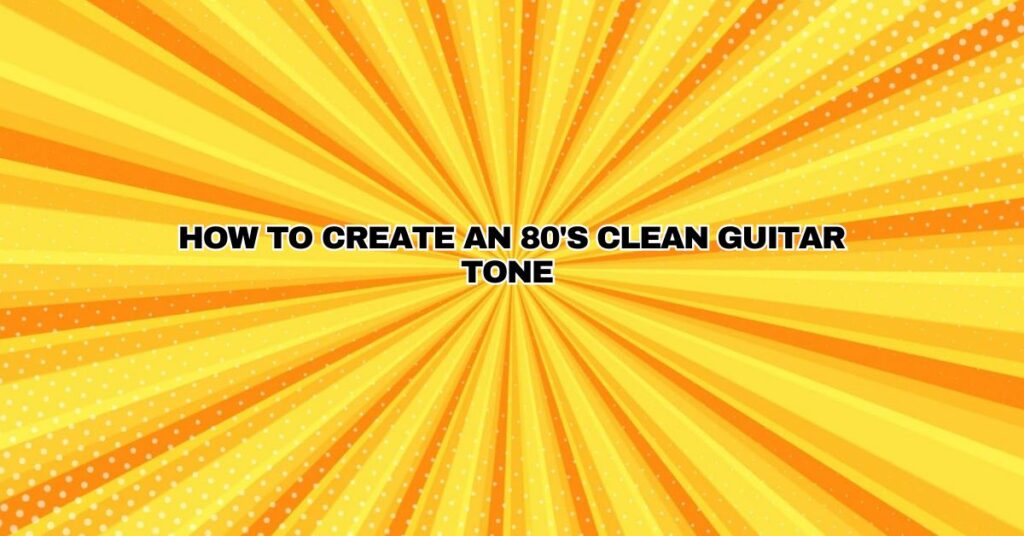The 1980s marked an era of musical innovation and creativity. Among the many elements that defined this period, the guitar tones from that decade are particularly distinctive and beloved. The 80s offered a wide range of guitar sounds, from the iconic, saturated distortion of heavy metal to the shimmering, clean tones heard in pop, rock, and new wave music. In this comprehensive article, we will focus on the creation of an 80’s clean guitar tone, exploring the essential components and techniques that give rise to that iconic, nostalgic sound.
The Elements of an 80’s Clean Guitar Tone:
To create a truly authentic 80’s clean guitar tone, it’s essential to understand the various elements that contribute to this distinct sound. These elements include the choice of guitar, amplifier, effects, and playing techniques.
1. Guitar Selection:
Start with the right guitar. In the 80s, guitars with single coil pickups, such as the Fender Stratocaster and the Fender Telecaster, were widely used to achieve clean tones. These guitars have a bright and clear sound that was favored in many 80’s genres. However, other guitars with single coil or split-coil humbuckers can also work well, such as the Gibson ES-335 or the PRS Custom 24.
2. Amplifier Choice:
Selecting the appropriate amplifier is crucial. Tube amplifiers were a staple of the 80’s and can provide the warm and dynamic clean tones associated with the era. Amps from brands like Fender, Vox, and Mesa/Boogie are frequently associated with 80’s clean tones. You’ll want an amp that can deliver pristine cleans at higher volumes without breaking up into overdrive.
3. Settings on the Amplifier:
Dial in your amplifier settings to achieve that quintessential 80’s clean tone. Begin with a clean channel, and set the EQ controls to emphasize the midrange and treble frequencies while keeping the bass under control. A touch of reverb can add that lush, spacious quality to the sound. Experiment with the volume to find the right level for your playing environment.
4. Effects and Processing:
The 80’s were known for their use of effects, even in clean guitar tones. Chorus and delay were popular choices, contributing to a sense of depth and width in the sound. Many classic 80’s songs featured the lush, swirling tones of chorus effects. Consider adding a chorus pedal or a rack-mounted unit to your signal chain. If you’re going for a specific 80’s sound, don’t be afraid to use a touch of compression to even out your dynamics.
5. Technique and Playing Style:
To capture the essence of 80’s clean guitar playing, it’s essential to pay attention to your technique. The 80’s were marked by expressive and melodic playing styles. Vibrato, bends, and sliding between notes were common techniques that added character to clean guitar parts. Practice your vibrato and bending techniques to add that expressive touch to your playing.
Songs to Study:
To truly grasp the 80’s clean guitar tone, it’s beneficial to listen to and study songs from that era. Some classic tracks that feature this sound include:
- Dire Straits – “Sultans of Swing”: Mark Knopfler’s clean guitar tone in this song is legendary, showcasing the warm, articulate sound of a Fender Stratocaster.
- The Police – “Every Breath You Take”: Andy Summers used a chorus pedal to create the iconic clean sound in this song, emphasizing the shimmering quality of the 80’s tone.
- George Benson – “Give Me the Night”: This song features jazz-fusion clean guitar tones that are full of soul and finesse. George Benson’s signature guitar sound is a great reference for clean tones with a jazzy twist.
Conclusion: The Timeless Appeal of 80’s Clean Tones
Creating an 80’s clean guitar tone is not just about the gear and settings; it’s about capturing the spirit and style of that era. With the right guitar, amplifier, effects, and technique, you can transport your audience back to the 1980s, a time when clean guitar tones were as memorable and iconic as the artists who played them. So, channel your inner 80’s guitarist, and embark on a journey through sound that’s sure to evoke nostalgia and inspire new musical adventures.


